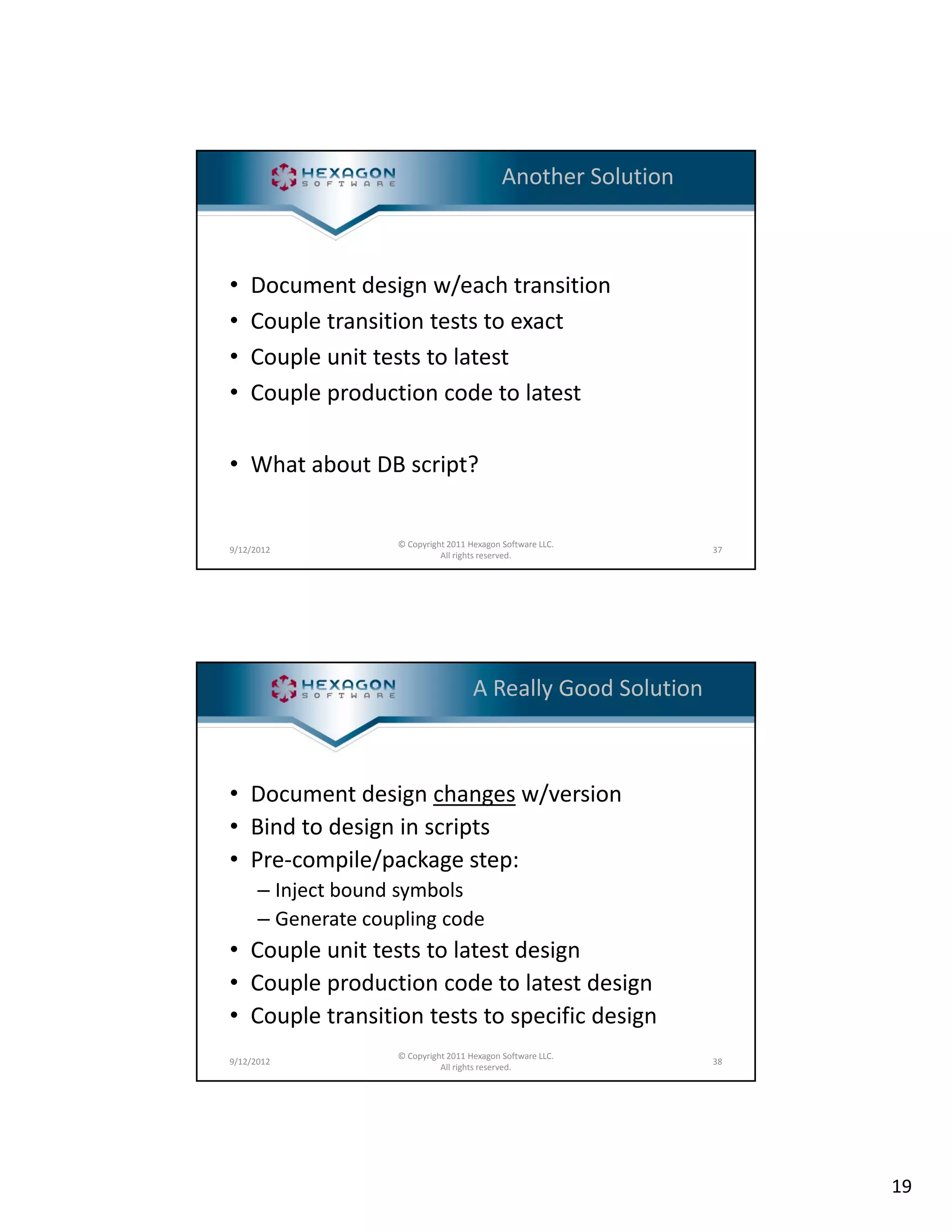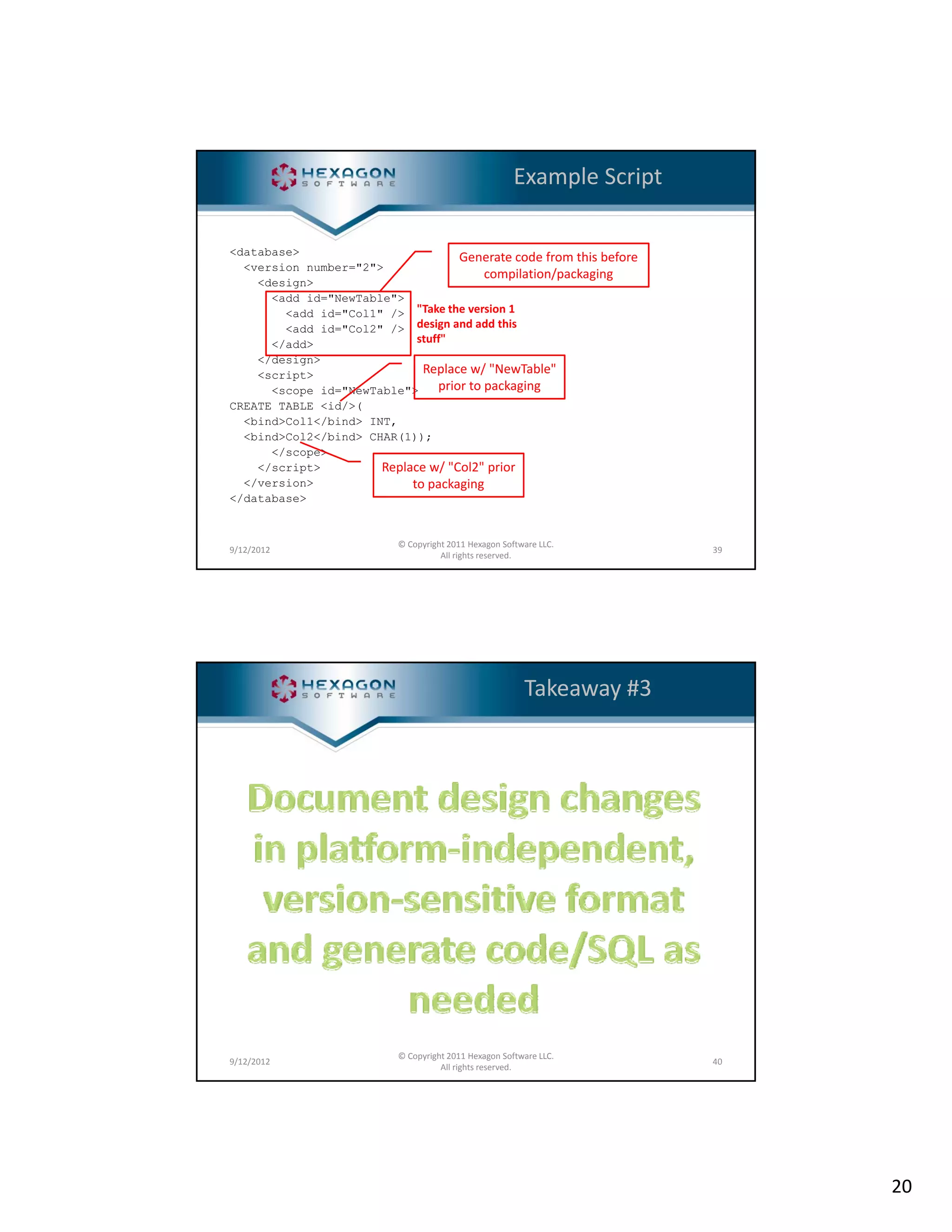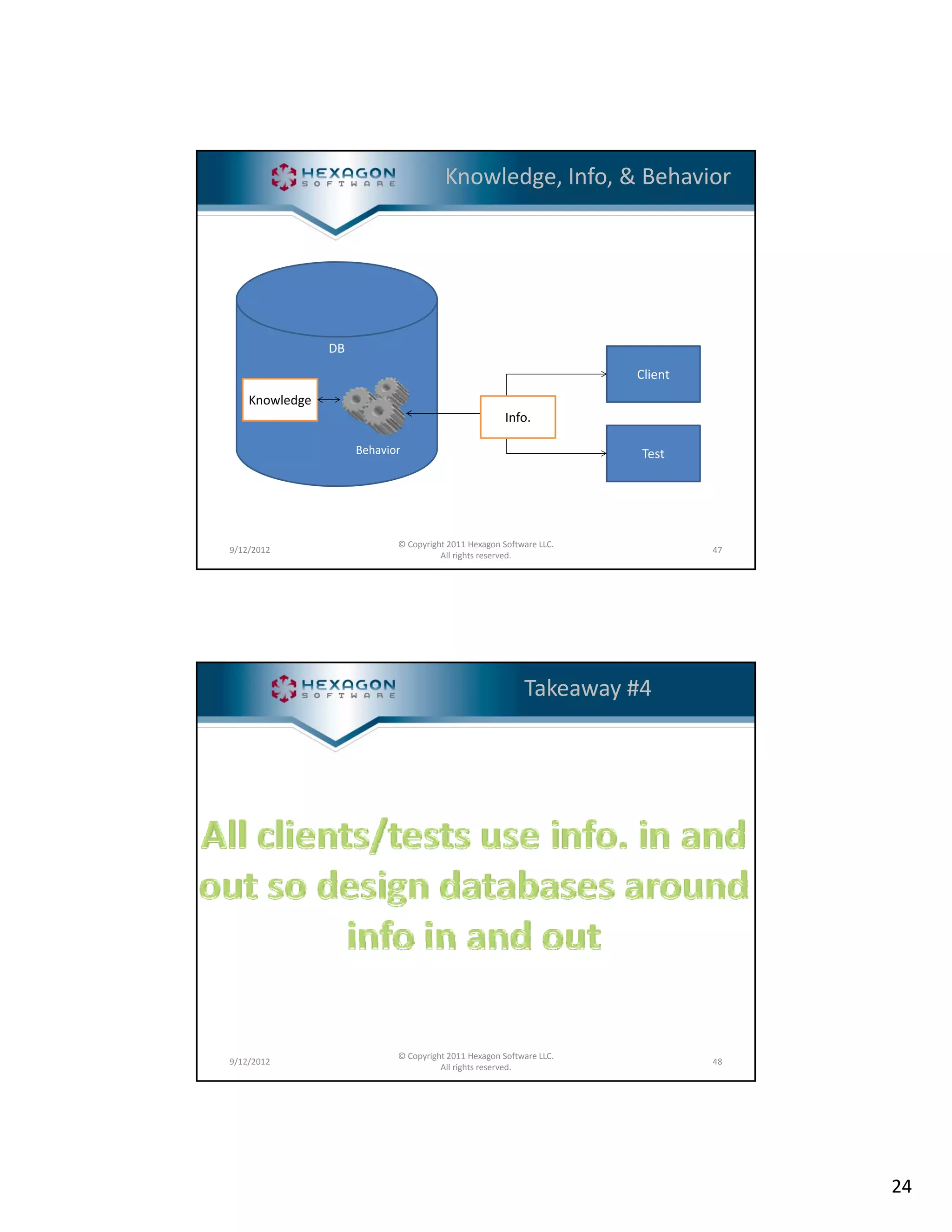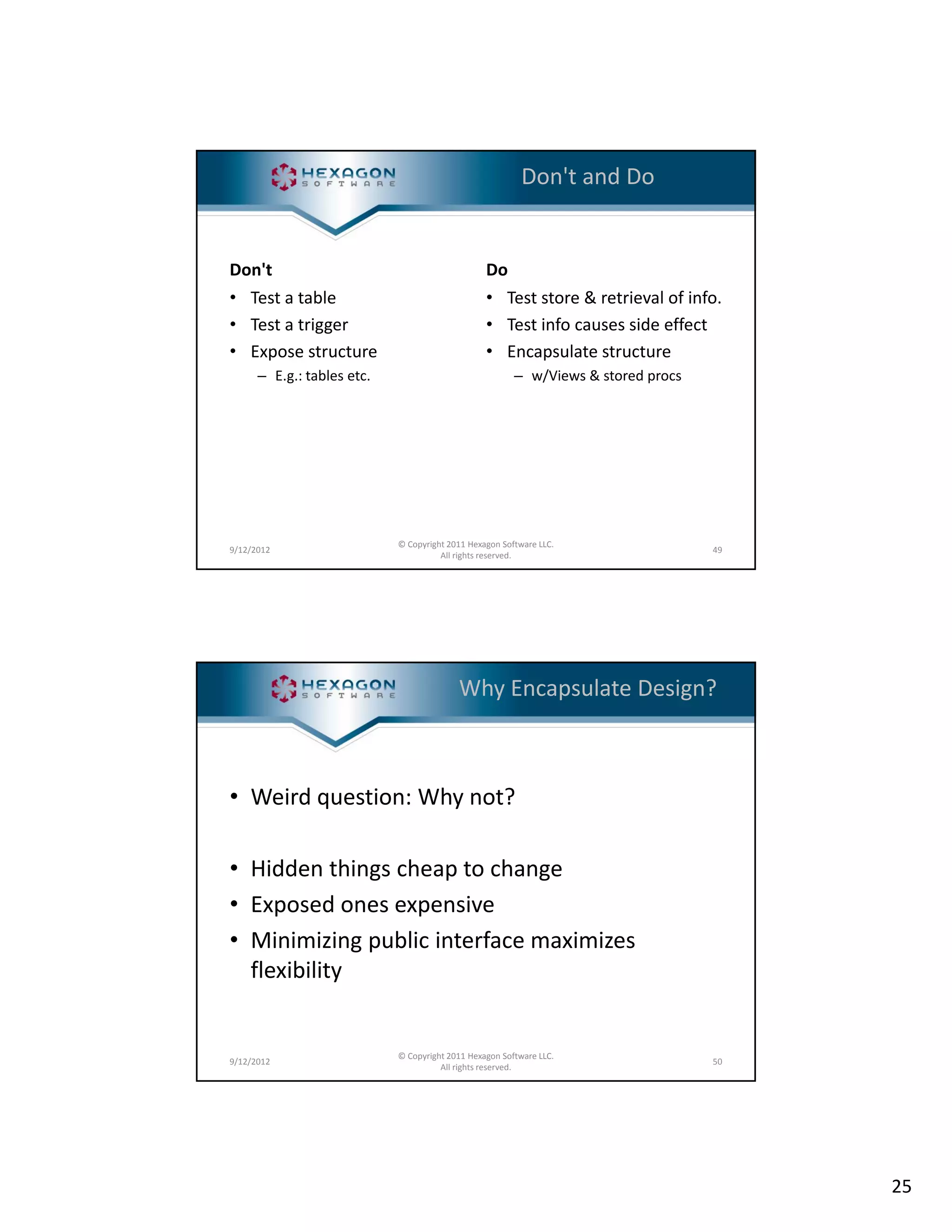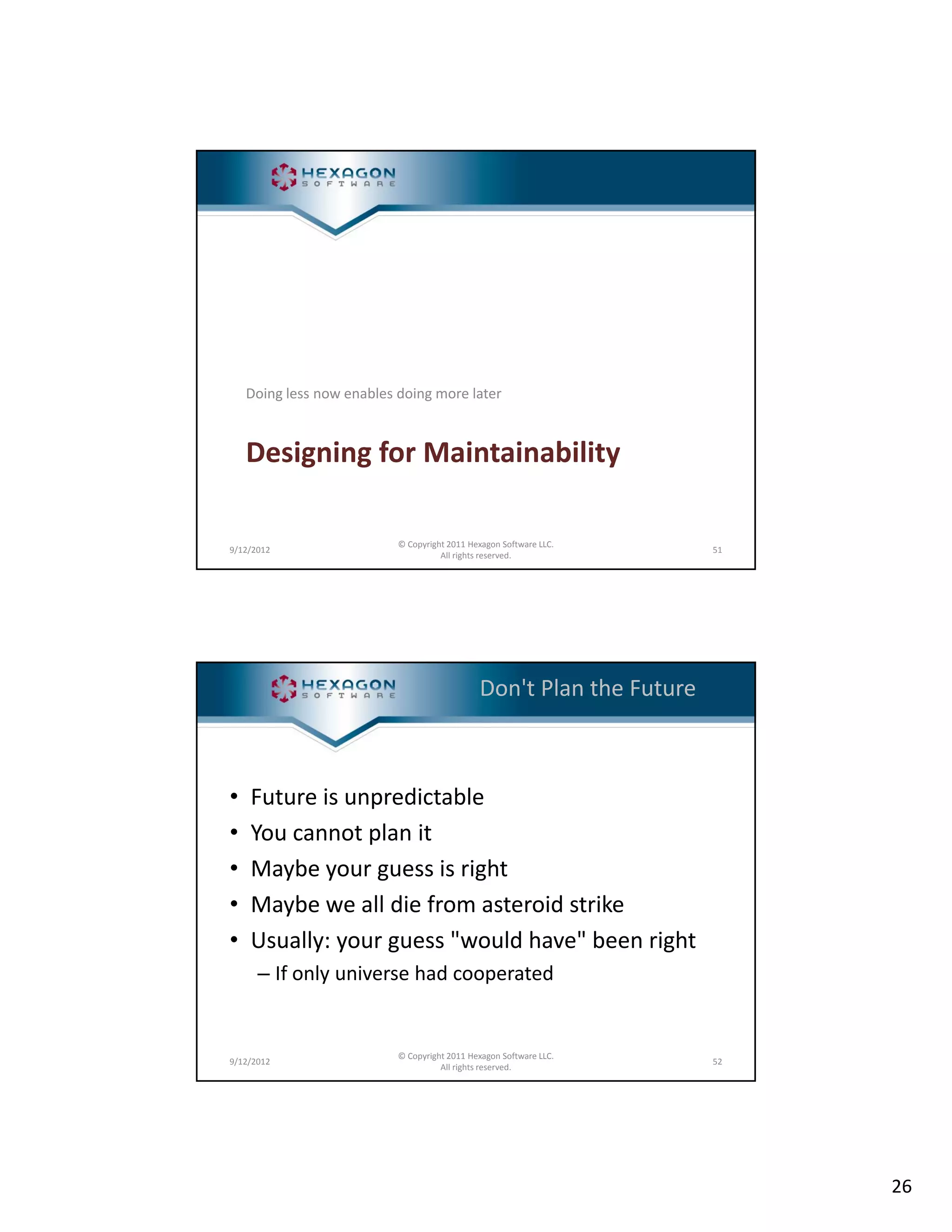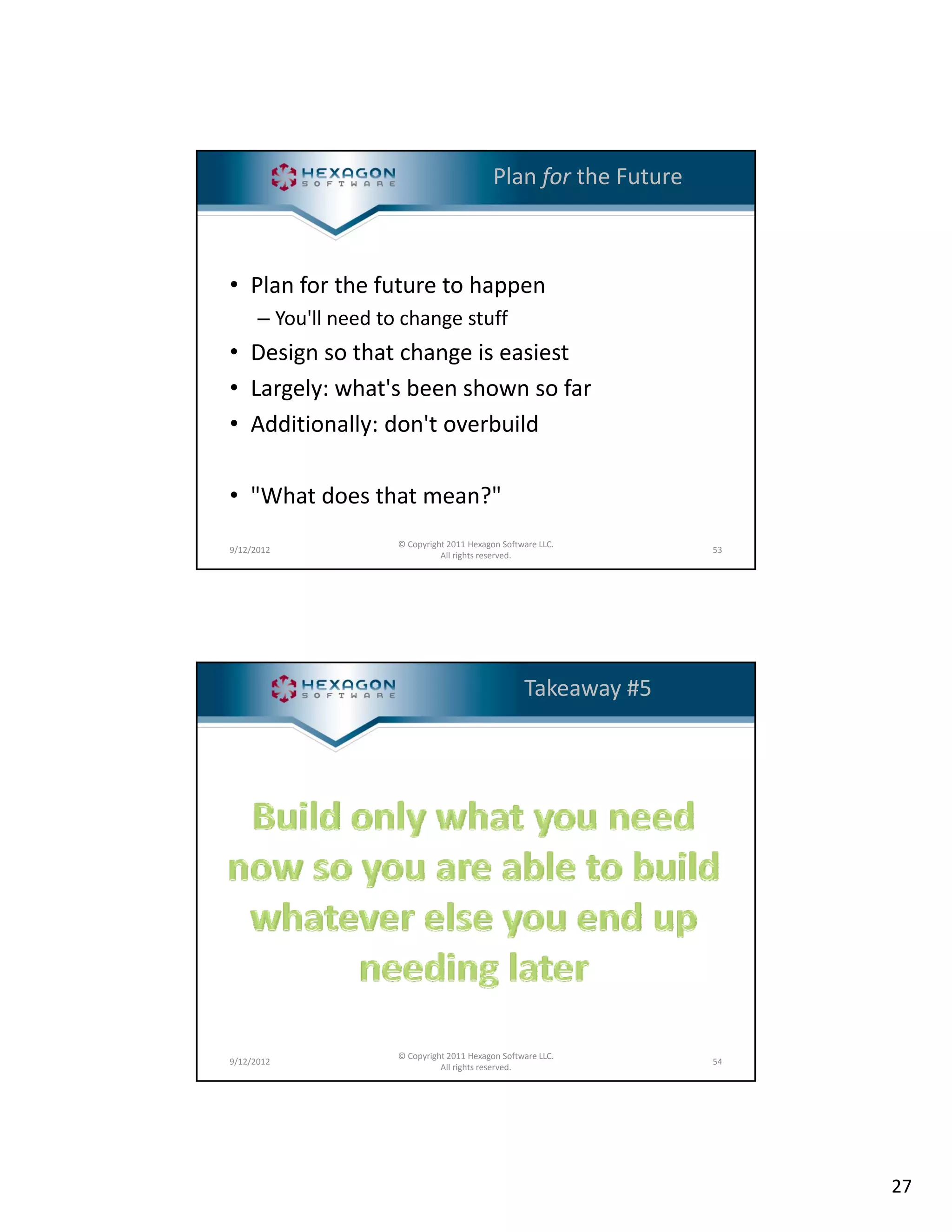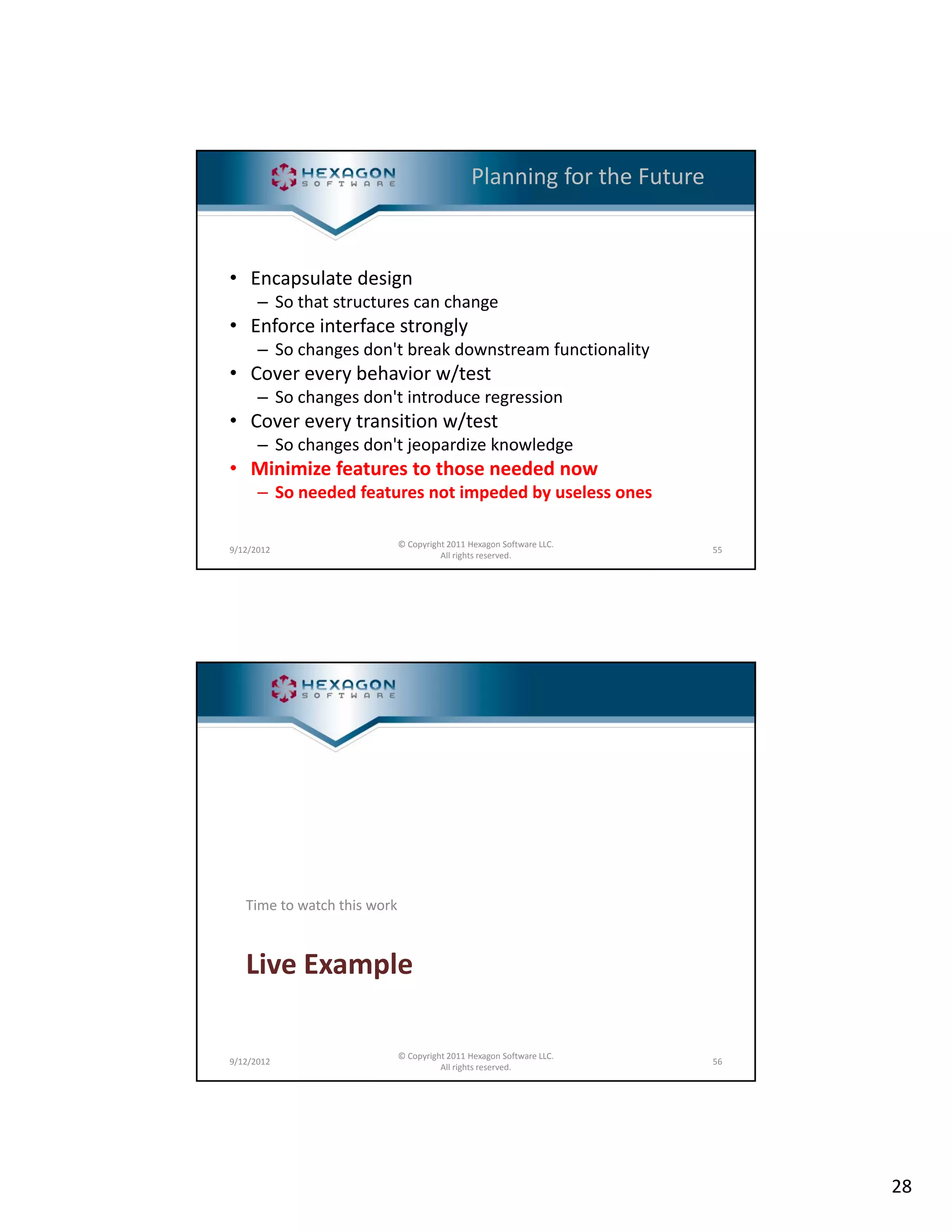Max Guernsey presents on database development using test-driven and object-oriented methodologies, emphasizing the importance of good practices in software development. The discussion focuses on transitioning to agile practices in database management, using test-driven development (TDD) to create resilient database designs, and establishing robust testing strategies for both test and production environments. The presentation highlights challenges, solutions, and best practices for enforcing interfaces and defining behaviors within a systematic framework for database development.
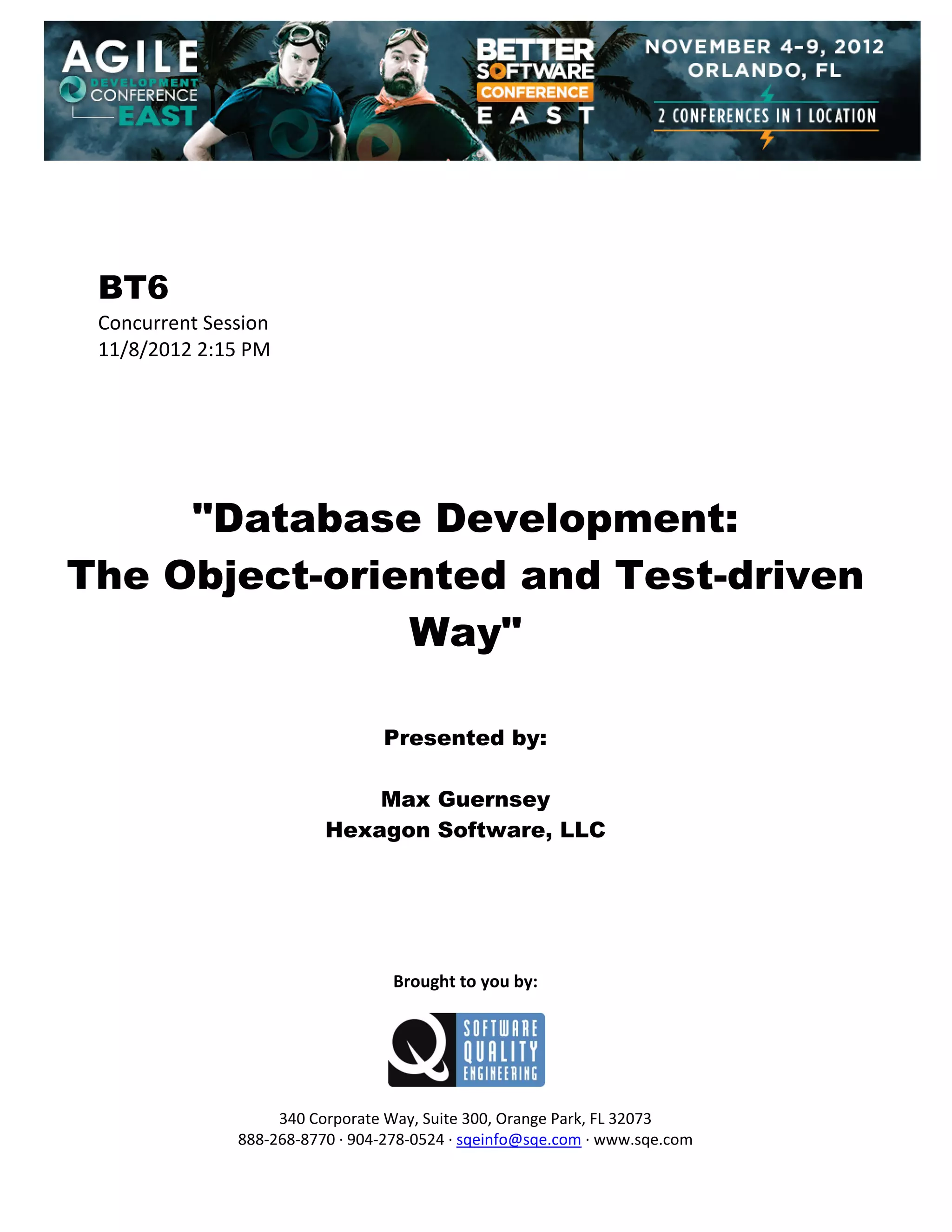
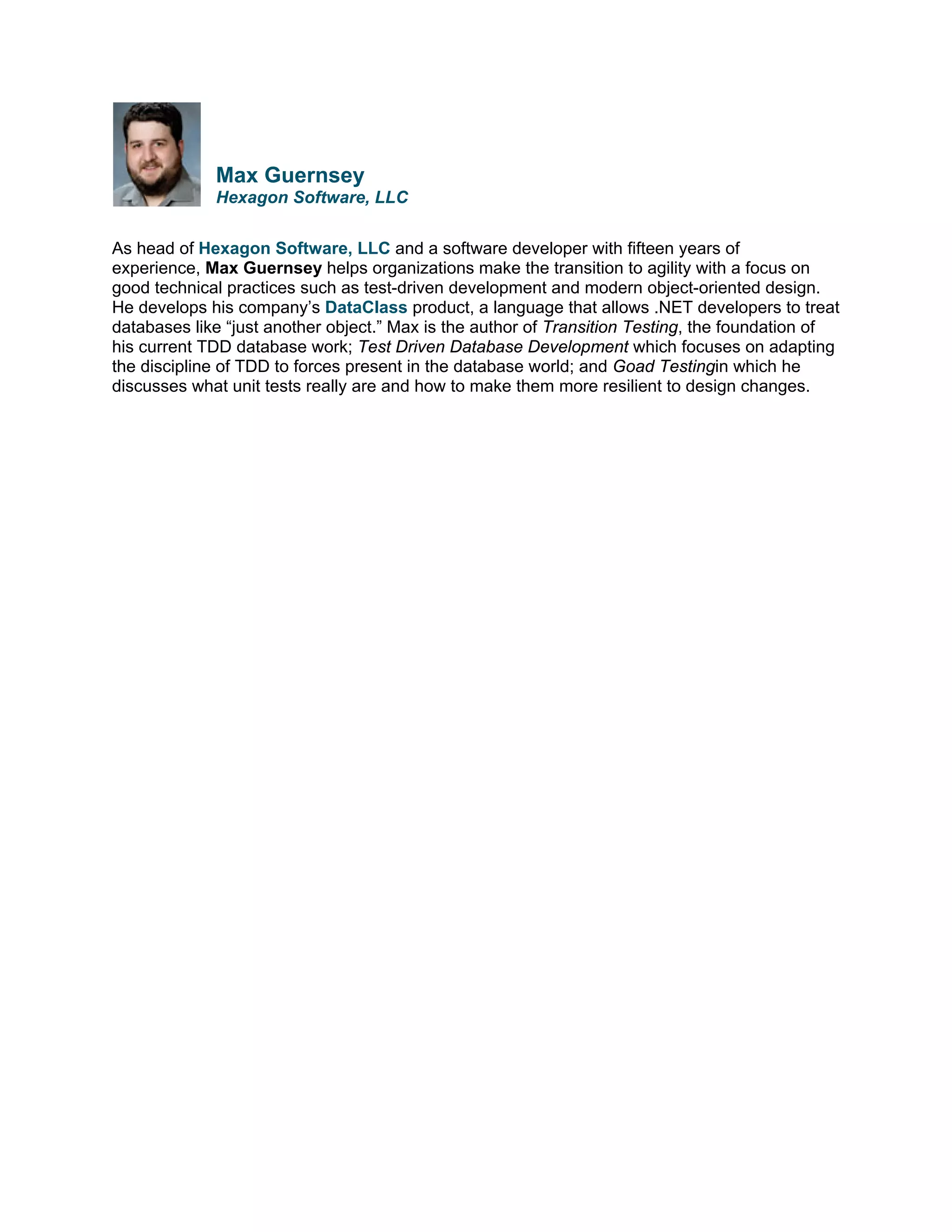
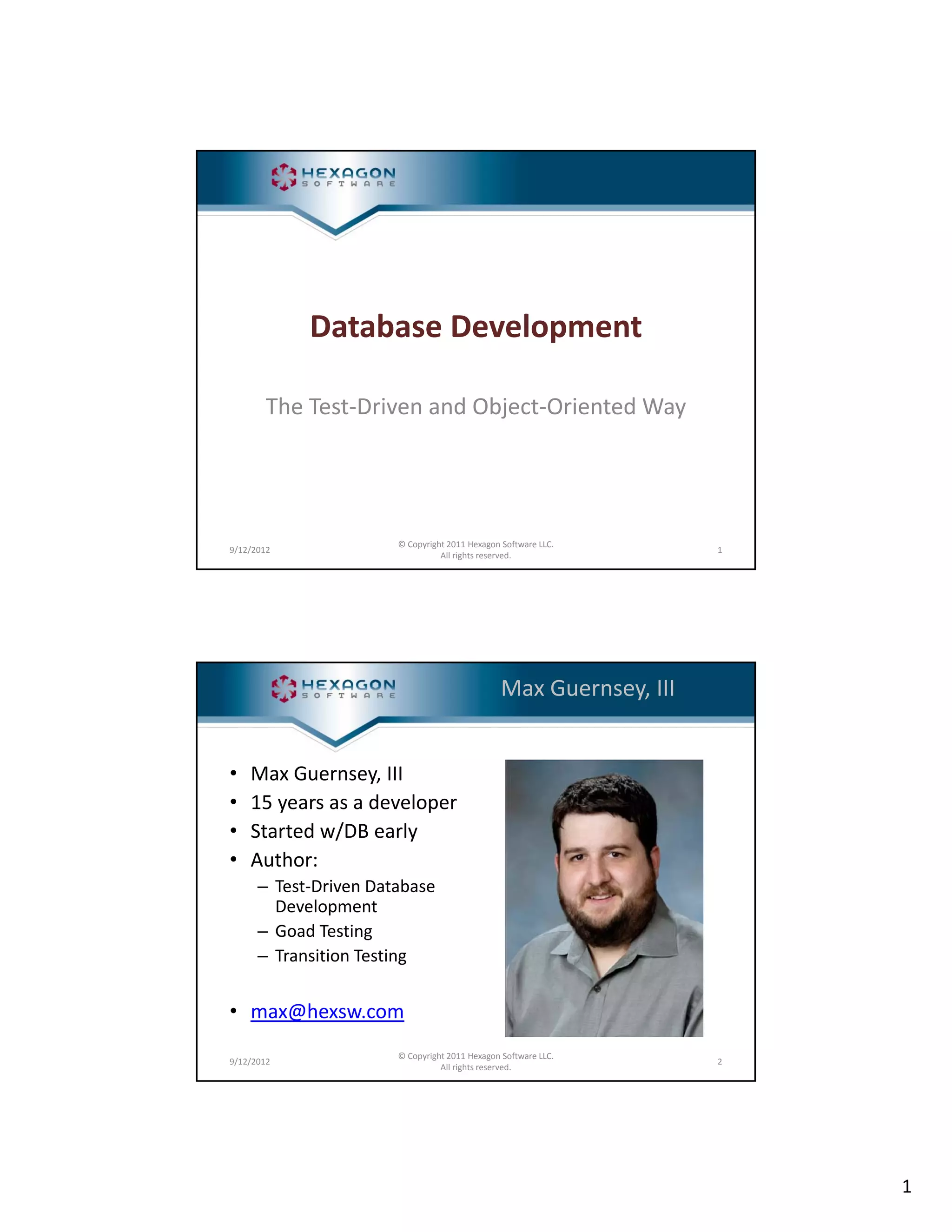


![TDD in Middle Tier Code [Test] public void AddEmployee() { var company = Company GetInstance(); Company.GetInstance(); var employee = Employee.GetInstance(); Setup Test Runner Test Runner Test1 company.AddEmployee(employee); Trigger Test2 Test3 Assert.That( company.Employees, Has.Some.SameAs(employee); Assertion ThisTest Test5 } Test6 Test7 Test8 9/12/2012 © Copyright 2011 Hexagon Software LLC. All rights reserved. 7 TDD in Middle Tier Code [Test] public void AddEmployee() { var company = Company GetInstance(); Company.GetInstance(); var employee = Employee.GetInstance(); Setup company.AddEmployee(employee); Trigger Assert.That( company.Employees, Has.Some.SameAs(employee); Assertion } 9/12/2012 © Copyright 2011 Hexagon Software LLC. All rights reserved. 8 4](https://image.slidesharecdn.com/12cbscebt6-131211100210-phpapp02/75/Database-Development-The-Object-oriented-and-Test-driven-Way-6-2048.jpg)
![Typical DB Test [Test] public void CannotAddLineItemWithoutType() { DBTestHelper.ClearDatabase(); DBTestHelper ClearDatabase(); Incomplete setup var cartId = DBTestHelper.CreateCart(); try { DBTestHelper.InsertLineItem( Trigger cart: cartId, itemTypeId: DBNull.Value, count: 100); } catch (ConstraintViolationException) { return; } Assertion Assert.Fail(); } 9/12/2012 © Copyright 2011 Hexagon Software LLC. All rights reserved. 9 How Was the DB Created? • You don’t know • No guarantee DB works like production • Potential for variation • Leads to... – ...rigorous “controls” over change – ...general “slow down” culture ...general slow down culture – ...ultimately: bad database designs • DB test suites must cover creation 9/12/2012 © Copyright 2011 Hexagon Software LLC. All rights reserved. 10 5](https://image.slidesharecdn.com/12cbscebt6-131211100210-phpapp02/75/Database-Development-The-Object-oriented-and-Test-driven-Way-7-2048.jpg)
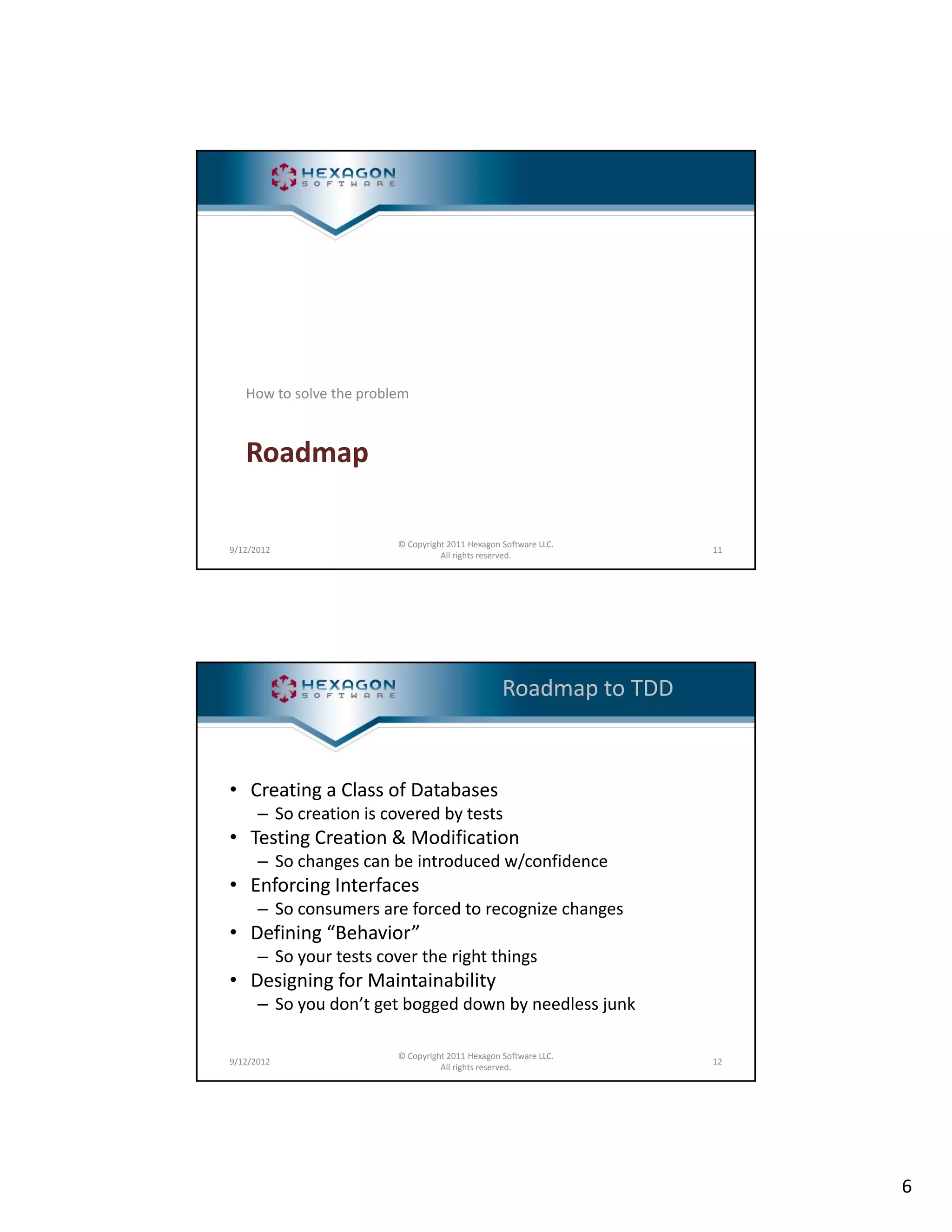
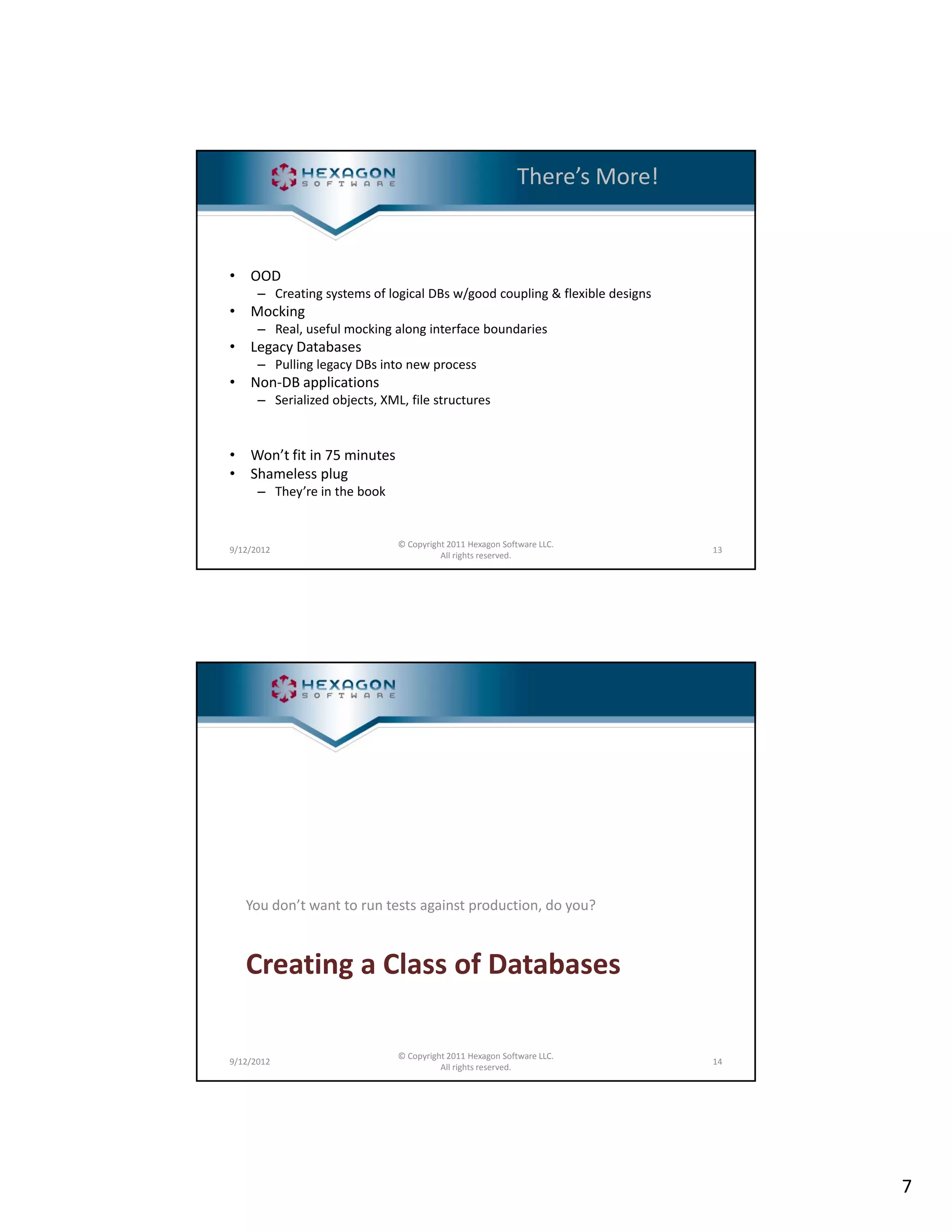
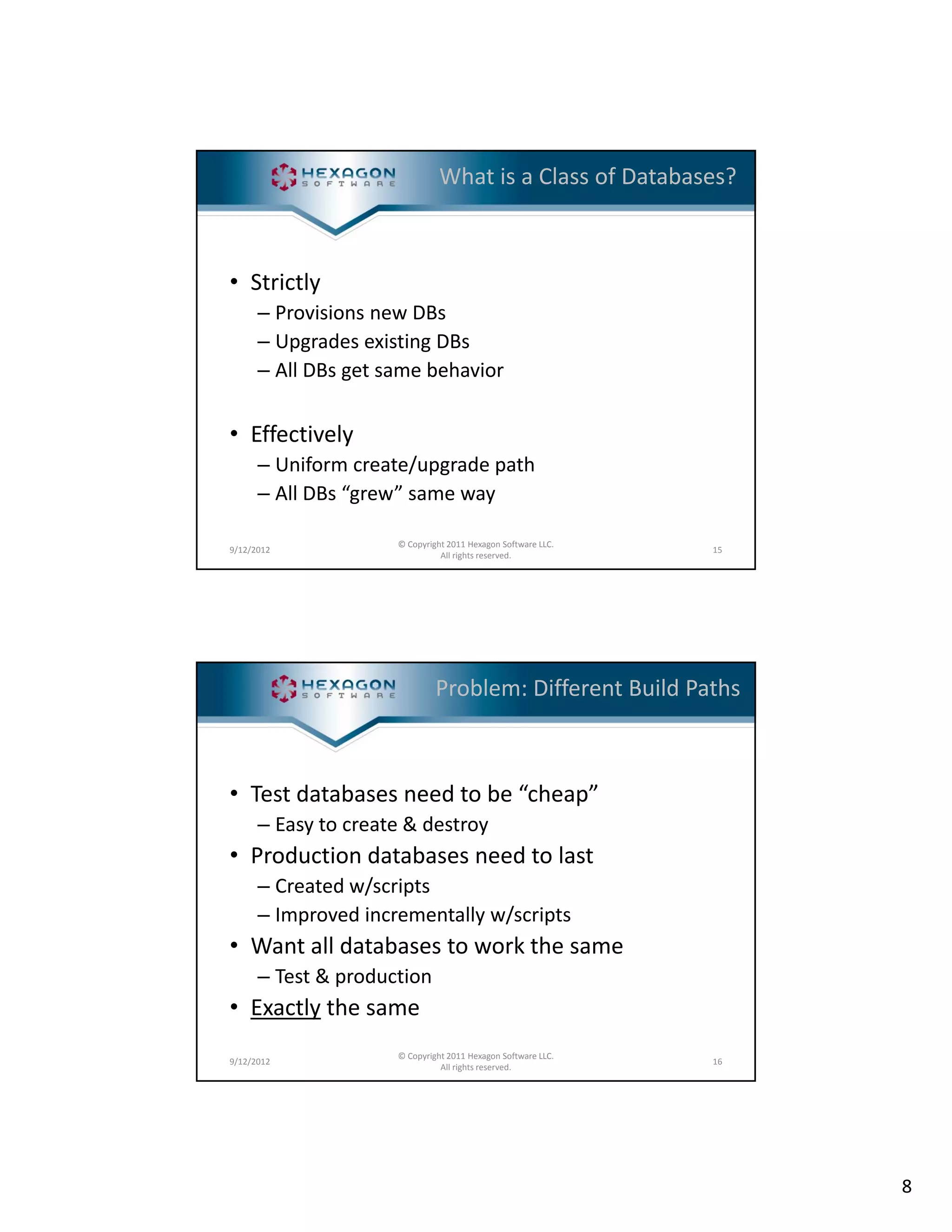

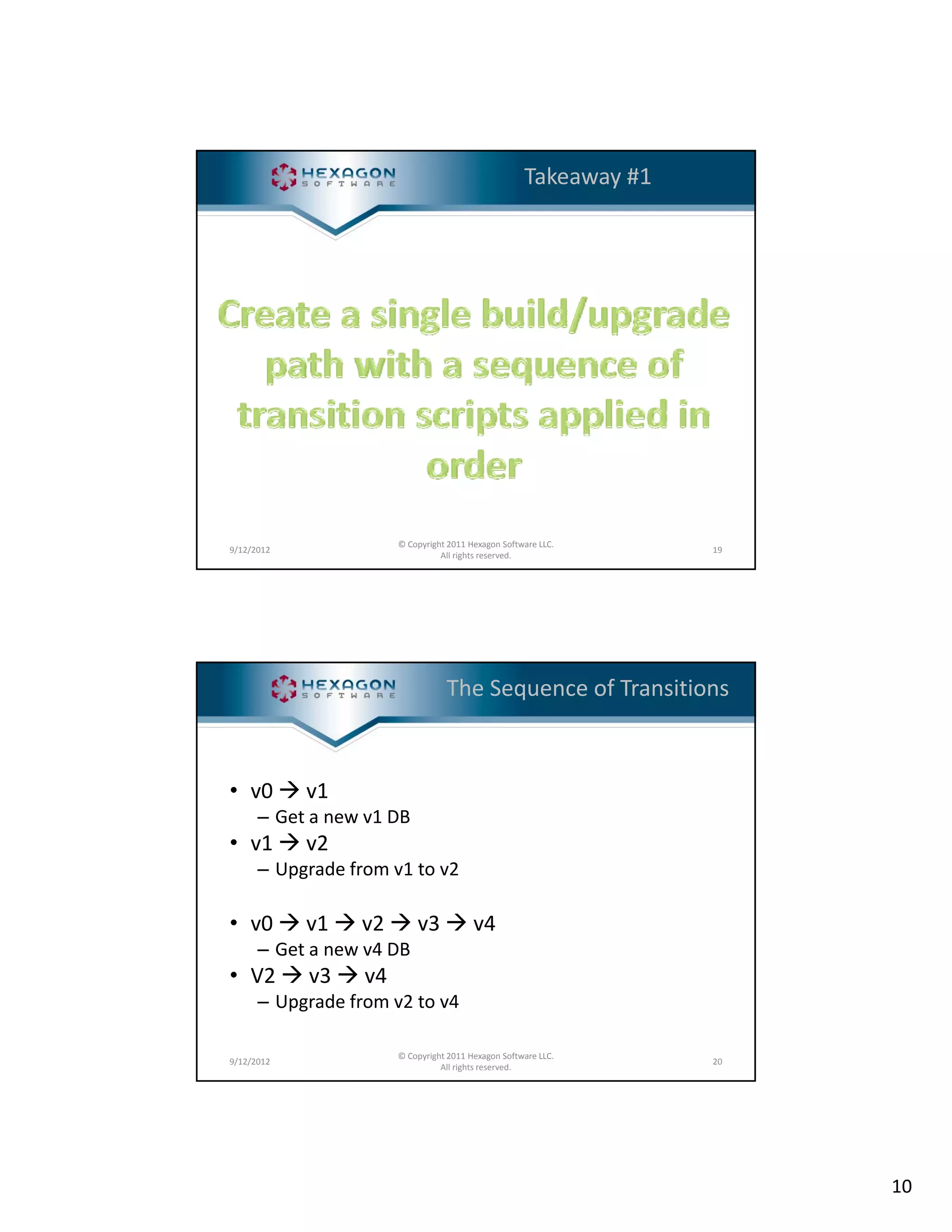
![Example: Writing a Test [Test] public void HasAnAccountsTable() { // you can do this once per suite if you want MyDatabase.Create(connection, 2); DB created by test Test Runner Test Runner Test1 connection.ExecuteSql("SELECT * FROM Accounts"); Test2 Test3 // exception thrown if no Accounts table ThisTest } Test5 Test6 Test7 Test8 9/12/2012 © Copyright 2011 Hexagon Software LLC. All rights reserved. 21 Example: Starting DB Script <database> <version number="1"> <script> <!-- Build the database --> </script> </version> </database> 9/12/2012 © Copyright 2011 Hexagon Software LLC. All rights reserved. 22 11](https://image.slidesharecdn.com/12cbscebt6-131211100210-phpapp02/75/Database-Development-The-Object-oriented-and-Test-driven-Way-13-2048.jpg)
![Example: Updating DB Design <database> <version number="1"> <script> <!-- Build the database --> </script> </version> <version number="2"> <script> <![CDATA[ CREATE Accounts(INT ID, NAME CHAR(23)); ]]> </version> </database> Test Runner Test Runner Test1 Test2 Test3 ThisTest Test5 Test6 Test7 Test8 9/12/2012 © Copyright 2011 Hexagon Software LLC. All rights reserved. 23 Reducing the risk of change rather than its frequency Safely Changing Design 9/12/2012 © Copyright 2011 Hexagon Software LLC. All rights reserved. 24 12](https://image.slidesharecdn.com/12cbscebt6-131211100210-phpapp02/75/Database-Development-The-Object-oriented-and-Test-driven-Way-14-2048.jpg)
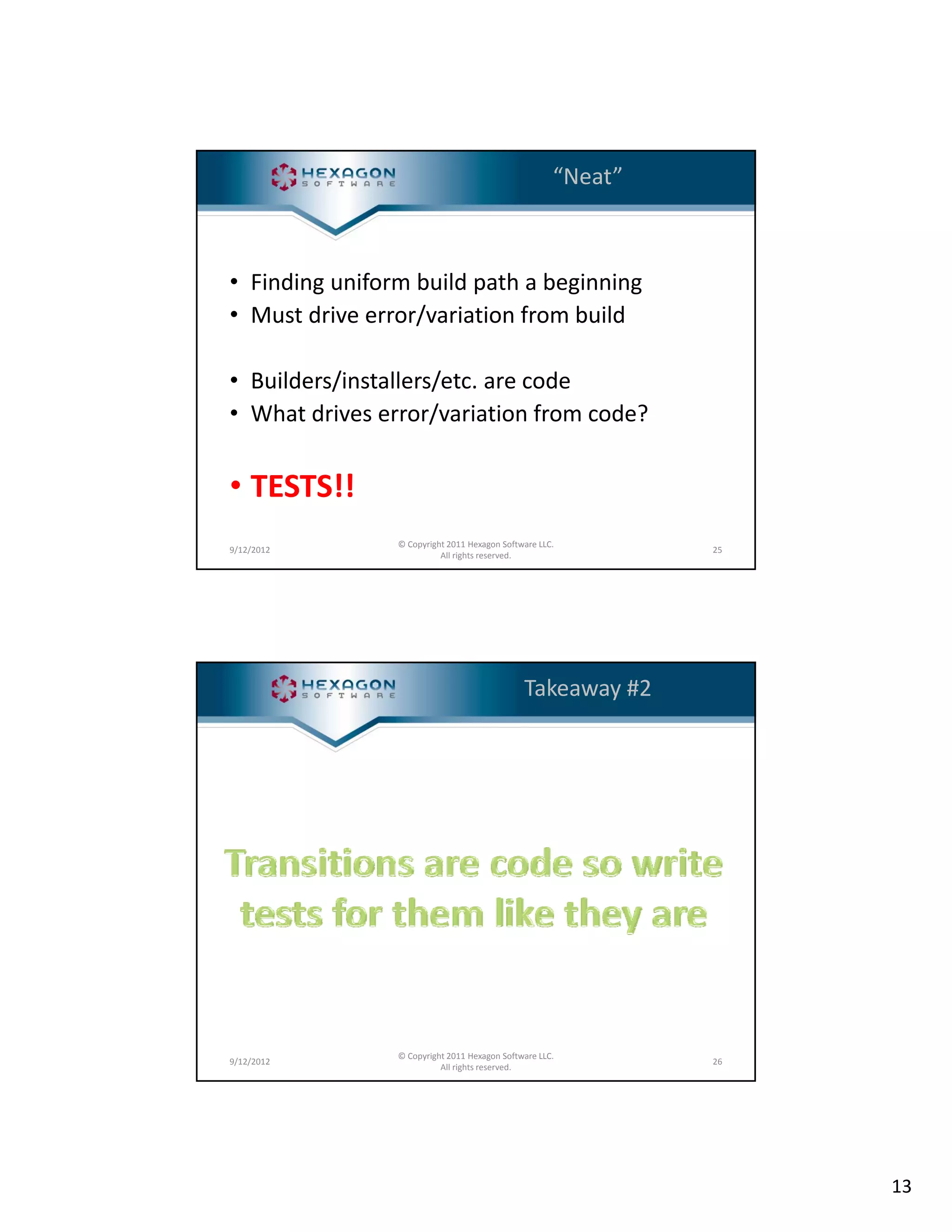
![A Transition Test • Setup – Bring database up to version X – Populate • Trigger – Transition to subsequent version • Assertion – Prove that content was preserved 9/12/2012 © Copyright 2011 Hexagon Software LLC. All rights reserved. 27 Example: A Transition Test [Test] public void ContactsFactoredFromAccountsInV9() { MyDatabase.Create(connection, 8); var accountId = connection.ExecuteScalar(@" INSERT INTO Accounts(Name, PWHash, Email) VALUES('MaxGuernseyIII', 'pwhash', 'max@hexsw.com'); SELECT SCOPE_IDENTITY();"); Test Runner Test Runner Test1 Test2 Test3 MyDatabase.Create(connection, 9); ThisTest var emails = connection.ExecuteSelectList(@" SELECT Email FROM Contacts WHERE AccountID = ?", accountId); Assert.That( emails, Is.EqualTo(new[] { "max@hexsw.com" }); Test5 Test6 Test7 Test8 } 9/12/2012 © Copyright 2011 Hexagon Software LLC. All rights reserved. 28 14](https://image.slidesharecdn.com/12cbscebt6-131211100210-phpapp02/75/Database-Development-The-Object-oriented-and-Test-driven-Way-16-2048.jpg)
![Example: Creating Upgrade Script <database> <version number="9"> <script> p <![CDATA[ CREATE TABLE Contacts( AccountId INT FOREIGN KEY REFERENCES Account(ID), Email NVARCHAR(2048)); Test Runner Test Runner Test1 Test2 Test3 INSERT INTO Contacts(AccountID, Email) SELECT ID, Email FROM Accounts; ThisTest Test5 ALTER TABLE A Accounts DROP COLUMN E il t Email; ]]> </script> </version> </database> 9/12/2012 © Copyright 2011 Hexagon Software LLC. All rights reserved. Test6 Test7 Test8 29 Getting the best feedback you can Enforcing Interfaces 9/12/2012 © Copyright 2011 Hexagon Software LLC. All rights reserved. 30 15](https://image.slidesharecdn.com/12cbscebt6-131211100210-phpapp02/75/Database-Development-The-Object-oriented-and-Test-driven-Way-17-2048.jpg)
![Remember This? [Test] public void HasAnAccountsTable() { // you can do this once per suite if you want MyDatabase.Create(connection, 2); connection.ExecuteSql("SELECT * FROM Accounts"); // exception thrown if no Accounts table } 9/12/2012 © Copyright 2011 Hexagon Software LLC. All rights reserved. 31 Duplication Is Evil • • • • Two tests is annoying Two tests is annoying Ten is a pain Fifty is untenable Any realistic number impossible to maintain w/duplication 9/12/2012 © Copyright 2011 Hexagon Software LLC. All rights reserved. 32 16](https://image.slidesharecdn.com/12cbscebt6-131211100210-phpapp02/75/Database-Development-The-Object-oriented-and-Test-driven-Way-18-2048.jpg)
![Easy Solution [Test] public void HasAnAccountsTable() { // you can do this once p y per suite if y you want MyDatabase.Create(connection, MyDatabase.CurrentVersion); connection.ExecuteSql("SELECT * FROM Accounts"); // exception thrown if no Accounts table } ... public class MyDatabase { public const int CurrentVersion = 2; ... } 9/12/2012 © Copyright 2011 Hexagon Software LLC. All rights reserved. 33 It’s More Pervasive Version numbers just most obvious • Version numbers just most obvious • Symbols are the real evil... 9/12/2012 © Copyright 2011 Hexagon Software LLC. All rights reserved. 34 17](https://image.slidesharecdn.com/12cbscebt6-131211100210-phpapp02/75/Database-Development-The-Object-oriented-and-Test-driven-Way-19-2048.jpg)
![Duplication Abounds [Test] public void CanInsertData() { connection.Execute(@"INSERT INTO Data(Time, Reading) VALUES( 4:31:01.103 17.02.2009 VALUES('4:31:01 103 17 02 2009', 041 908);”); 041.908); ); } ... <script> CREATE TABLE Data(Time DATETIME, Reading NUMERIC(6,3)); </script> ... private void EnterReading(double reading) { connection.Execute( @"INSERT INTO Data(Time, Reading) VALUES(?,?)", DateTime.Now, reading); } ... private IEnumerable<double> GetOrderedReadings() { return connection.Execute<double>(@"SELECT Reading FROM Data ORDER BY Time ASC"); } 9/12/2012 © Copyright 2011 Hexagon Software LLC. All rights reserved. 35 One Solution Minimize w/string constants • Minimize w/string constants • Couple to constants from tests & code • What about interface changes? – Transition tests need old design Transition tests need old design – Unit tests & production code always need latest 9/12/2012 © Copyright 2011 Hexagon Software LLC. All rights reserved. 36 18](https://image.slidesharecdn.com/12cbscebt6-131211100210-phpapp02/75/Database-Development-The-Object-oriented-and-Test-driven-Way-20-2048.jpg)
